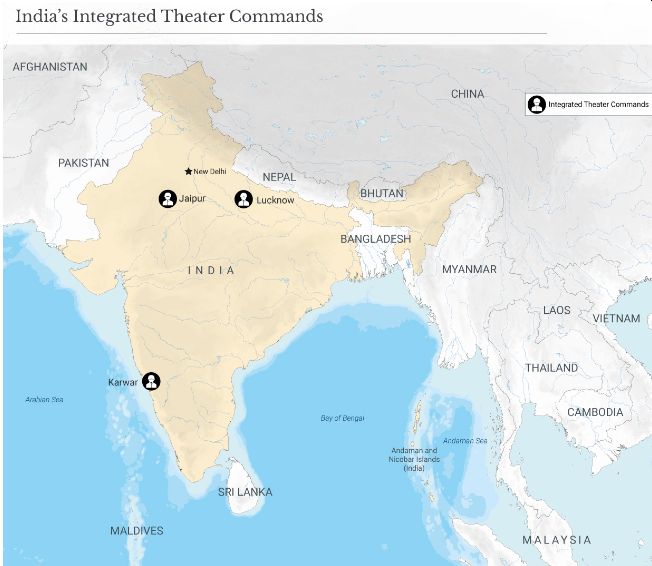By Eric Vandenbroeck and co-workers
India’s Massive Military Restructuring
India’s strategic posture has
been in a state of churn for several years, compelling New Delhi to embark on
the most significant military reorganization since the country’s founding in
1947. The South Asian giant is moving away from its historical focus on its
western flank with nuclear rival Pakistan to focus on the bigger challenges of
dealing with the growing threat of conflict with China and building up its
power projection capabilities in the Indian Ocean basin. Addressing these
emerging challenges is the principal driver behind the Indian military’s move
to establish three new tri-service theater commands – i.e., centers that
involve all three military branches (the army, air force, and navy). The sheer
magnitude of the military restructuring and the usual bureaucratic inertia
means it will be many years before the process is completed – though the
country’s rapid economic growth will help propel its defense capabilities in
the future.
India is set to launch the first of
three integrated theater commands next month when the country celebrates the
76th anniversary of its independence. According to Indian media reports, the
Jaipur-based Southwestern Command will focus on the western border with
Pakistan. A second Lucknow-based Northern Command will focus on the increasing
threats from China along the Himalayan border. Meanwhile, The Maritime Command
will be headquartered in Karwar, in the southwestern state of Karnataka,
focusing on the defense of the southern coast and power projection capabilities
in the Indian Ocean basin and beyond.

Four-star Army and
air force commanders will head the first two commands rotationally. In
contrast, the third will be headed by a naval officer reporting directly to the
country’s top military officer, the Chief of Defense Staff, a post created just
four years ago. These senior officers will effectively lead military
operations, while each of the three service chiefs will be responsible for
recruiting and maintaining their respective military branches. Before this
reorganization, the military had only two tri-service commands – the Andaman
and Nicobar Command, responsible for the maritime area bordering Myanmar,
Thailand, and Indonesia, and the Strategic Forces Command, in charge
of the country’s nuclear arsenal. The new integrated platforms will comprise 17
existing commands across the military, seven each from the Army and air force
and three from the Navy. There are also plans for other joint commands led by
three-star officers responsible for logistics, training, cyber, space,
missiles, and intelligence. They will report to the chief of Integrated Defense
Staff under the chairman of the Chiefs of Staff Committee.
These massive changes
to the structure and functionality of the Indian armed forces reflect shifts in
the regional and global security situation over the past 15 years or so.
India’s main security challenge from Pakistan is not what it was decades ago
when the two neighbors fought four wars in 1947, 1965, 1971, and 1999. This is
mainly due to the emergence of social, political, and economic crises that have
weakened Islamabad to unprecedented levels. Its military leadership, which
dominates many elements of Pakistani society and politics, has recently tried
to steer the country toward normalizing relations and trade with India.
Pakistan is increasingly focused on its western flank, which in recent years
has supplanted its eastern border with India as its main security threat due to
the rising insurgencies led by Islamist rebels and Baloch separatists. Over the
past quarter century, the threat to India from Pakistan has emanated largely
from proxy Islamist non-state actors, which, since the late 2000s, have gone
from being an asset to a significant liability for Islamabad.
Still, New Delhi
can’t lower its guard too much, given the uncertainty surrounding the security
situation in Pakistan in the long term. Meanwhile, India is also concerned
about the threat from China, which has been increasingly hostile for the past
decade. New Delhi faces security challenges from Beijing in
three strategic sectors: the northwestern, central, and northeastern
regions straddling the 2,200-mile-long India-China border. This border will
likely heat up as U.S.-China competition intensifies and as U.S.-India
alignment grows, especially considering that India is the one area in the world
where the Chinese have the experience and capabilities to act militarily.
While it faces no
immediate threats from the Indian Ocean, New Delhi must still dedicate
resources to its southern flank. This will be crucial to India’s ability to
become a major military ally of the United States in the broader Indo-Pacific
region. Even its own imperative to move from regional to global power
necessitates force projection capabilities on the maritime front. For India,
maritime security has become a more significant focus since Beijing launched
its so-called String of Pearls strategy – a push to build military and
commercial assets along the Indian Ocean. However, this strategy has been
largely unsuccessful, one reason Beijing has been trying to keep India focused
on its shared border in the Himalayas instead of its southern flank.
Ultimately, the new command structure is designed to
allow India to protect against any threats from Pakistan and China, especially
if the two countries collude against New Delhi. It’s also aimed at preparing
India for a major partnership with the United States and other allies to ensure
regional security. But despite India’s projected growth in the years ahead,
this will be a herculean task for the world’s fourth-largest military.
For updates click hompage here